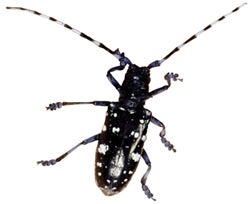There’s no doubt Worcester’s Asian Longhorned Beetle infestation is already big news.
Local, state and federal government agencies have moved into crisis mode, with hotlines and dire warnings about moving logs from the wrong place. Local homeowners worry about the future of their shady streets and neighborhood parks. But if the beetles aren’t successfully contained, the news will get much, much worse, according to some people who make their living from the Central Massachusetts forests.
“My opinion is this is potentially the most serious threat to New England forests that has happened probably in the last two centuries,” said Gregory Cox, executive director of the Belchertown-based Massachusetts Forest Land Owners Association, which represents about 800 owners of woodlands in the state.
How Far Can They Go?
At the heart of the uncertainty gripping the local forestry industry is the question of how far the beetles will spread. So far, they have been spotted mainly in Worcester, with one identified just over the West Boylston line, according to Suzanne Bond, a spokeswoman for the USDA’s Animal and Plant Health Inspection Service.
Officials have banned the transportation of forest products from a 33-mile quarantine area that includes northern Worcester and parts of Boylston, Holden, Shrewsbury and West Boylston. They are now inspecting trees in the area and will soon begin an extermination effort that will include cutting the doomed trees that already harbor the beetles and treating their neighbors with chemicals to prevent the bugs from spreading.
The regulated area is fairly urban, but it just overlaps wooded land in the Boylston area that is part of the Wachusett Reservoir watershed. If more of the bugs are found, the quarantine area could expand well into the forested land.
That’s what worries Roger Plourde, a Worcester-based consulting forester who works with private land owners in Worcester County.
“Right now it’s not big, but there’s the potential to be huge,” he said.
If the quarantine moves farther into the Wachusett watershed, it could start to affect some foresting, Plourde said. He said the area is managed to harvest wood products while maintaining water quality, and it provides quite a few jobs. The situation would get worse if the beetles found their way to the larger forests around the Quabbin Reservoir, he said, and if they spread to Vermont, New Hampshire or even Canada, it could be a very bad situation. Plourde said 20,000 people are employed in the forestry industry in Massachusetts alone.
Of course the beetle infestation doesn’t affect all forestry by any means. The major species that may harbor the insects are maples and birches, and Bond said transport of other kinds of trees, like pine, from the quarantined area is allowed.
Still, the fact that maple is among the host trees has many worried. Cox said sugar maple is probably the second most important hardwood tree in New England. It’s used for high-end products like furniture, flooring and baseball bats. Much of the maple cut in New England is exported to Europe, through Canada, Cox said.
Bond said trees from the quarantined area could be chipped and then moved elsewhere, since chipping destroys the beetles in all stages of their life cycle, but that would make the high-end uses of maple impossible.
Fred Heyes, the owner of Heyes Forest Products Inc. in Orange, said he worries the beetles’ effect on his operations could be “huge.” He said his land is mostly located within a 25-mile radius of Orange, about 30 miles from Worcester, so he’s just hoping containment efforts will be successful.
City Beetle, Country Beetle
Bond said there’s good reason to hope it will be. Other Asian Longhorned Beetle infestations in New Jersey, New York and Chicago have been; Bond said DNA evidence from the insects shows that each of those outbreaks was caused by separate cases of beetles stowing away in shipping materials from Asia.
But Plourde notes that this is the first time an infestation has happened so close to significant wooded areas. He said if the beetles moved into the forests to the north it would create all kinds of new problems.
“They don’t want that to happen,” he said. “Just sort of the scale of control, it’s mind-boggling to me as I think about it.”
Bond agreed that Massachusetts is different from the areas where the beetles have showed up in the past. She said experts are now looking into the best way to apply techniques that have been successful in urban areas to forested territory like the Quabbin.
“I wouldn’t necessarily call it uncharted territory, but it is new,” she said.
Bond noted that the area is sensitive not only because of the significant New England forestry industry but also because of the importance of tourism, nurseries and maple sugar.
Scott Amburgey, who runs the Amburgey Farm Sugarhouse in Ashburnham with his wife, said he has wood lots on his property as well as maples for tapping, and if he or his neighbors inadvertently brought up infested wood it could decimate the area.
For all the dangers the beetles present, Plourde said there could be one bright spot. If many trees need to be cut, he said, local loggers should get some work out of the situation. Bond said the job of cutting infested trees, which is set to begin after the first hard frost of winter, will be put out to bid. So far, though, there’s no knowing just how big a job it will be.
Click here for links to additional sources of info. on Asian Longhorned Beetles.

